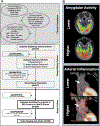Stress-Associated Neurobiological Pathway Linking Socioeconomic Disparities to Cardiovascular Disease
- PMID: 31248544
- PMCID: PMC6767929
- DOI: 10.1016/j.jacc.2019.04.042
Stress-Associated Neurobiological Pathway Linking Socioeconomic Disparities to Cardiovascular Disease
Abstract
Background: Lower socioeconomic status (SES) associates with a higher risk of major adverse cardiac events (MACE) via mechanisms that are not well understood.
Objectives: Because psychosocial stress is more prevalent among those with low SES, this study tested the hypothesis that stress-associated neurobiological pathways involving up-regulated inflammation in part mediate the link between lower SES and MACE.
Methods: A total of 509 individuals, median age 55 years (interquartile range: 45 to 66 years), underwent clinically indicated whole-body 18F-fluorodeoxyglucose positron emission tomography/computed tomography imaging and met pre-defined inclusion criteria, including absence of known cardiovascular disease or active cancer. Baseline hematopoietic tissue activity, arterial inflammation, and in a subset of 289, resting amygdalar metabolism (a measure of stress-associated neural activity) were quantified using validated 18F-fluorodeoxyglucose positron emission tomography/computed tomography methods. SES was captured by neighborhood SES factors (e.g., median household income and crime). MACE within 5 years of imaging was adjudicated.
Results: Over a median 4.0 years, 40 individuals experienced MACE. Baseline income inversely associated with amygdalar activity (standardized β: -0.157 [95% confidence interval (CI): -0.266 to -0.041]; p = 0.007) and arterial inflammation (β: -0.10 [95% CI: -0.18 to -0.14]; p = 0.022). Further, income associated with subsequent MACE (standardized hazard ratio: 0.67 [95% CI: 0.47 to 0.96]; p = 0.029) after multivariable adjustments. Mediation analysis demonstrated that the path of: ↓ neighborhood income to ↑ amygdalar activity to ↑ bone marrow activity to ↑ arterial inflammation to ↑ MACE was significant (β: -0.01 [95% CI: -0.06 to -0.001]; p < 0.05).
Conclusions: Lower SES: 1) associates with higher amygdalar activity; and 2) independently predicts MACE via a serial pathway that includes higher amygdalar activity, bone marrow activity, and arterial inflammation. These findings illuminate a stress-associated neurobiological mechanism by which SES disparities may potentiate adverse health outcomes.
Keywords: cardiovascular disease; neurobiology; positron emission tomography; socioeconomic disparities; stress.
Copyright © 2019 American College of Cardiology Foundation. Published by Elsevier Inc. All rights reserved.
Figures





Comment in
-
Mechanistic Understanding of Socioeconomic Disparities in Cardiovascular Disease.J Am Coll Cardiol. 2019 Jul 2;73(25):3256-3258. doi: 10.1016/j.jacc.2019.04.043. J Am Coll Cardiol. 2019. PMID: 31248545 No abstract available.
References
-
- In: Anderson NB, Bulatao RA, Cohen B, editors. Critical Perspectives on Racial and Ethnic Differences in Health in Late Life Washington (DC), 2004. - PubMed
Publication types
MeSH terms
Substances
Grants and funding
LinkOut - more resources
Full Text Sources
Other Literature Sources
Medical
Miscellaneous

